When the sea is dyed red...
The red tide is a work of several microscopic algae, phytoplankton. These beings are found in all oceans and, despite their small size, they have great importance in oceanic ecosystems.
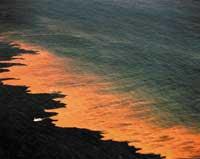
Thanks to the activity of algae that form phytoplankton, a sufficient food is produced for all aquatic animals. Therefore, they are directly responsible for life in the oceans, without phytoplankton, without fish.
The living beings that form phytoplankton are characterized by being unicellular, float and obtain the necessary energy to live through photosynthesis. The group is very broad and there is still much to be investigated. There are barely visible species with the microscope and experts still do not know what is the function that many of them play within the ecosystem.
As with many other beings, the species that have been studied most are those that directly affect the human being. In short, these algae are the basic food of aquatic ecosystems, whose variation of populations affects directly in the population of fish, which, logically, influences the human being.
But what is the red tide?
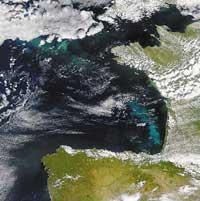
To begin with, it must be said that the phenomenon is poorly called because it has nothing to do with tides and is not always red. However, all variants of the phenomenon have a common origin: the population of a microscopic species of algae grows sharply.
Sometimes, from day to day, the water of the sea or lakes changes color and smells bad. On other occasions, although it does not change color, the pile of fish appears dead in the water or is totally banned from cracking on the coast.
The phenomenon is only the limit situation of a natural process. The sudden growth of phytoplankton population occurs every year, are cyclical and without them there would be no life in the sea or lakes. The phenomenon is known as bloom in English, when translated directly, flowering. Throughout the spring, the amount of phytoplankton in water increases considerably, which allows the food chain of aquatic ecosystems to be launched.
In spring, when the water temperature begins to be tempered, the upper and lower layers of water are mixed. As a consequence, water is enriched with minerals and the appropriate conditions are created for the growth of algae. Algae are used to grow and multiply constantly. At the same time, the hatching of the eggs of many aquatic animals occurs, since there is more food than throughout the year.
However, by the end of summer, although the upper layer of water continues to warm, the lower one is cold, so there is no confusion. This causes the amount of minerals in the upper layer of water to decrease considerably and the algae do not have enough food to grow. If the rest of the animals are added to this, the algae population decreases considerably.
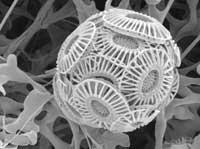
In autumn the waters are remixed and more minerals appear in the water. But since water is much colder, in autumn it grows much less phytoplankton. Therefore, it can be said that the most spectacular growth occurs in spring.
The cycle is celebrated annually, both in the sea and in the lakes. However, as has been mentioned at the beginning, sometimes, and for no special reason, the population of a kind of microorganism increases more than normal and, instead of benefiting from the ecosystem, it does it wrong. That is precisely the red tide.
Main groups of algae that make up phytoplankton
- Diatoms : Rigid cell wall of silica. They appear in the sea and in fresh water. They are not able to move and achieve their floatability by introducing elongators into the cell wall.
- Dinoflagellates: They are smaller than diatoms (10 microns are also known). They have a rigid cell wall and two flagella. Thanks to them, they have a great capacity to move through the water.
- Cocolitofórida : They are protected with calcite plates. They usually have a size of 20 microns and each cell has more than thirty plates.
- Cyanobacteria: are photosynthesizing bacteria. These are also very small, but in many cases they tend to group, so they can be seen visually. Prochlorococcus is the most abundant species in the world.
- Peak: more than ten classes of algae enter this group. They are very small (between 0.2 and 2 microns) and often cannot be seen under a microscope. Biochemical methods will be used for detection.
Red, brown and green waters
However, all red tides are not harmful and those that are not often seen are much more dangerous. Therefore, although all are grouped under the same name, there are many types and their influence is different.
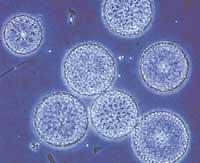

The pigments that the algae use to realize the photosynthesis are those that give color to the water. For example, cyanobacteria use green pigments, while other species of microorganisms use red or brown pigments. The red ones are mainly algae of the group of dinoflagellates, while the brown ones are crisofitas. Although not all algae that alter the color of water are toxic, their growth in watertight waters can cause problems. For some brown algae, such as bays, stagnant waters are the most suitable. When these algae grow in very high densities form an opaque layer on the surface of the water and do not let light pass to the bottom of the water. Therefore, algae that grow in the bottom of the water do not get enough light to survive.
If the high density of population of microorganisms persists for a long time, the population of the rest of the coastal algae can be affected and disrupt the normal functioning of the food chain: by considerably reducing the number of algae that inhabit the bottom, the amount of zooplankton also decreases considerably and, therefore, the populations of animals of all levels of the food chain.
Even in the lakes, if the appropriate conditions are given, there is a risk that the same phenomenon occurs, but in these cases the main responsible are cyanobacteria. Cyanobacteria are the most important bacterial group that makes photosynthesis. If these beings grow constantly, they form a green layer on the surface of the water, which, like brown algae, do not allow light to pass through, thus preventing the realization of photosynthesis. In addition, when cyanobacteria begin to die, they sink and break down. During the decomposition process, oxygen is consumed in the water and the survival of the rest of aquatic living beings is endangered. This, of course, has a great influence on the dynamics of the lake.
Other microorganisms are able to kill fish without changing the color of water. The sudden growth of these beings is discovered when thousands of fish appear dead. Fish do not produce toxins to kill, but are injured and die from wounds.
To hurt fish so severely, some microorganisms do nothing active. Guilt is in the design of your body, with designs suitable for floating in the upper layers of water. One of the best ways to float is to increase the body surface compared to weight.
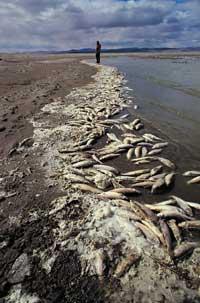
The algae of the genus Chaetoceros, for example, have needle shaped extensions integrated into the cell wall of silica to increase its surface. These structures are easily chained in the gills of the fish and, if they appear in high concentrations in the water, cause a huge disaster. In the gills of the fish accumulate microorganisms, cause wounds and cannot breathe with consistency. In the end they drown.
Another particular case is that of the piscicidal Pfiesteria dinoflagellada. It does not produce thorny remains or toxins, but has a huge capacity to kill fish. Scientists have long been trying to guess what the mystery of this being is, but it is not easy.
The life cycle of this microorganism consists of 24 phases that are not yet known. In one of these phases it produces deadly wounds in fish. The wounds cause the fish to die bleeding. However, scientists still do not know how and why they cause wounds.
Small and poisonous
More than four thousand unicellular algae are known, of which only 70-80 are harmful. Among the harmful, most of the species producing toxins belong to the group of dinoflagellates. The concentration of toxins that produces each being is very low and to achieve the necessary concentration to infect a human being it is necessary to ingest very high amounts of dinoflagellate. However, the food chain perfectly fulfills this accumulation.
In fact, many of the coastal mollusks are filtering: they trap their food by filtering the water from the sea, the aquatic plankton. If the amount of phytoplankton increases spectacularly, it does not cause any damage to animals, but toxins accumulate in your body. High concentrations of toxins can also be found in fish, as they feed on crustaceans that consume phytoplankton.
Therefore, the effect of toxin is manifested in animals that feed on seafood and fish, such as whales, marine birds and, of course, humans. In short, all of them are at the last level of the food chain, they are the animals that receive the highest concentrations of toxin.
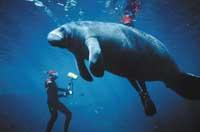
There are different types of toxins, each of them with different incidence in humans and in the rest of the animals. The most serious can cause death, but few cases have occurred in the world. For the moment, since antidotes against these toxins are not known, the only way to avoid intoxications is to avoid the consumption of animals contaminated with toxin.
Therefore, to be so small creatures, the influence of these unicellular algae is enormous, worthy of being considered. However, the solution to the problem is not easy, since in many cases it is not well known why there is a sudden growth.
Some believe that the excess nitrogen and phosphate that man pours into water is the main responsible. As a result of runoff, the presence of minerals in water is greater than there should be in summer and phytoplankton continues to grow, renouncing the natural cycle. Others believe that the increase in temperature on earth allows optimal conditions for the proliferation of algae.
Whatever the reason, each year this phenomenon occurs in more places and, in some case, it will have to give some solution in some way.
Effects of toxic algae Some algae in the group of dinoflagellates and diatoms produce toxins that cause various syndromes in the human being. At the moment, five are known, the first four syndromes are produced by seafood and the fifth by fish: DSP ( Diarrhetic Shellfish Poisoning )
NSP ( Neurotoxic Shellfish Poisoning )
PSP ( Paralitic Shellfish Poisoning )
ASP ( Amnésic Shellfish Poisoning )
Ciguatera Ciguatera
|





